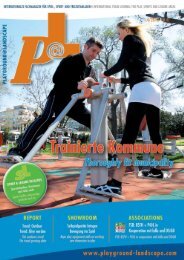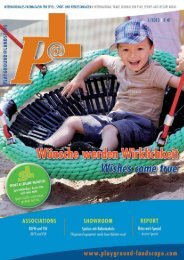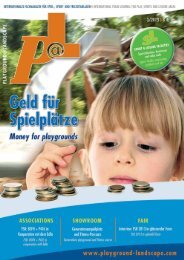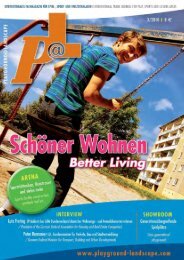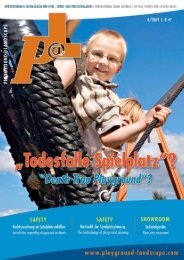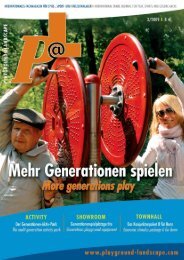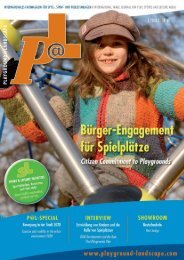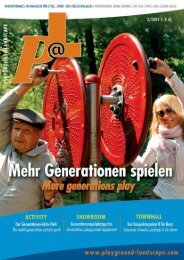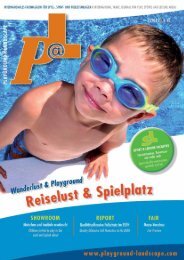Download - Playground@Landscape
Download - Playground@Landscape
Download - Playground@Landscape
Sie wollen auch ein ePaper? Erhöhen Sie die Reichweite Ihrer Titel.
YUMPU macht aus Druck-PDFs automatisch weboptimierte ePaper, die Google liebt.
COVERSTORY<br />
Das Bundesministerium für Familie,<br />
Senioren, Frauen und Jugend<br />
und die KfW Bankengruppe starteten<br />
schon zum 1. Februar 2013 zwei neue,<br />
zinsgünstige Förderprogramme für den<br />
Ausbau von Kinderbetreuungsangeboten.<br />
Hierfür stehen von 2013 bis 2015 KfW-Kredite<br />
im Umfang von 350 Millionen Euro für<br />
Kommunen und andere Träger von Kindertagesstätten<br />
zur Verfügung. Das Bundesfamilienministerium<br />
unterstützt das Vorhaben mit einer Zinsverbilligung.<br />
Die Förderung ist Bestandteil des Zehn-<br />
Punkte-Plans der Bundesregierung "Kindertagesbetreuung<br />
2013".<br />
Bewegung statt Verkopfung<br />
Neubau-, Umbau-, Umwandlungs-, Sanierungs-, Renovierungs-<br />
und Modernisierungsmaßnahmen sowie Ausstattungsinvestitionen<br />
in der Kita. Wichtig dabei bleibt das<br />
Thema „Bewegung“ – und damit auch das Außenareal mit<br />
dem Spielplatz. Die Sportwissenschaftlerin Professor Renate<br />
Zimmer forderte zum Thema „Bewegung im Kindesalter“: Um<br />
sich gesund zu entwickeln, müssen Kinder die Chance bekommen,<br />
sich täglich zu bewegen. Sie behauptet: „Toben<br />
macht schlau“. Renate Zimmer ist Professorin für Sportwissenschaft<br />
und Sportpädagogik an der Universität Osnabrück.<br />
Im Verlag Herder erschien von Ihr das Buch „Toben macht<br />
schlau – Bewegung statt Verkopfung“.<br />
Spielplatz U3 aus planerischer Sicht<br />
Das Thema „Kita“ bleibt spannend. Der Ausbau der Kinderbetreuung<br />
muss quantitativ und qualitativ vorangetrieben<br />
werden. Dabei wichtig: Was benötigt das Kind unter drei<br />
Jahren für einen Kinderspielplatz? Was muss für das Umfeld<br />
getan werden? Wie sieht dieses „Spielareal“ aus Sicht des<br />
On 1st February 2013 the Federal Ministry of Family Affairs,<br />
Senior Citizens, Women and Youth and the KfW Banking Group<br />
started up two new, low-interest incentive programmes for the construction<br />
of child care facilities. For this purpose, from 2013 to 2015 KfW<br />
are providing loans totalling 350 million Euros to local authorities and<br />
other providers of child care facilities. The Federal Ministry of Family<br />
Affairs is supporting the project with an interest-rate subsidy. The promotion<br />
is part of the Federal Government's ten point plan, "Children's<br />
Day Care Facilities 2013".<br />
Using the body instead of overloading the brain<br />
Measures for new construction, renovation, conversion, refurbishment<br />
and modernisation, plus investment in facilities in children's day care<br />
facilities. In these, the theme of movement remains an important one –<br />
and therefore also space out of doors for the playground. On the topic of<br />
"Movement in Infancy" the sports scientist Professor Renate Zimmer<br />
said: "In order to develop in a healthy manner, children must have the<br />
chance to take exercise every day". She stated, "Active play sharpens the<br />
wits". Renate Zimmer is Professor of Sports Science and Sports Education<br />
at the University of Osnabrück. The Herder Publishing House has<br />
published her book, Toben macht schlau – Bewegung statt Verkopfung<br />
(Active play sharpens the wits – using the body instead of overloading<br />
the brain).<br />
Playgrounds for the under 3's<br />
from the planning perspective<br />
The topic of children's day care facilities remains exciting. In the<br />
expansion of child care quantity and quality must be guaranteed. Important<br />
points are: What does the child under three years of age need in<br />
a children's playground? What needs to be done for the surrounding<br />
area? What do these "areas for play" look like from the landscape<br />
planner's perspective? What are the planning premises?<br />
Johannes Czerniejewski, Landscape planner NRW study group,<br />
AK NW, RMP Stephan Lenzen Landscape planners:<br />
DIN 1176/ 1177, GPSG, GUV-SR 2002 – safety is the highest<br />
imperative! Guidelines for the prevention of accidents are the bible for<br />
every planner. The requirement for risk and the fathoming of one's own<br />
boundaries is not only significant, but in particular for children under<br />
four years old, is an important step for developing the motor skills, the<br />
senses and creativity. Consequently, finding a healthy balance between<br />
safe play and the incentive to take calculated risks presents the planner<br />
with special tasks when dealing with younger children. The "ouch"<br />
effect is good and is an important part of healthy physical development.<br />
Unforeseeable dangers, however, must at all costs be avoided. The<br />
promotion of imagination and creativity must go hand in hand with safe<br />
design.<br />
Moreover the challenge also lies in creating playgrounds which will<br />
please all age groups and will satisfy all development needs. The playground<br />
user often goes there with several children of various ages. The<br />
greater the difference in age, the harder it is to do justice to the differing<br />
requirements. For this reason items of play equipment or combinations<br />
of games for all age groups are difficult to design. Separate zones in a<br />
play area for the different age groups make for a good playground. This,<br />
however, should not lead to insurmountable barriers or even widely<br />
18



